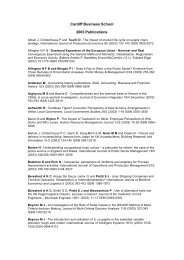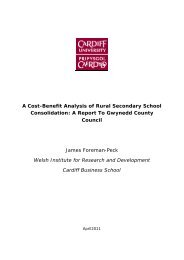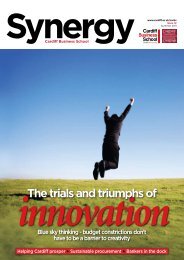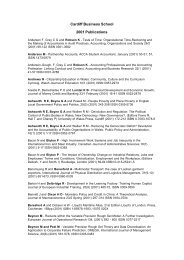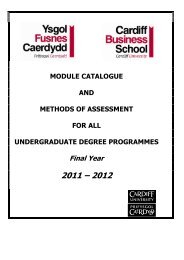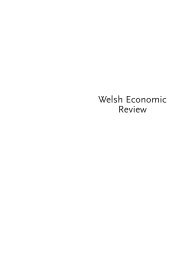Revisiting the Great Moderation using the Method of Indirect Inference
Revisiting the Great Moderation using the Method of Indirect Inference
Revisiting the Great Moderation using the Method of Indirect Inference
Create successful ePaper yourself
Turn your PDF publications into a flip-book with our unique Google optimized e-Paper software.
Table 1: Competing Rival Models<br />
Baseline framework<br />
IS curve x t = E t x t+1 ( 1 )(~{ t<br />
E t t+1 ) + v t<br />
Phillips curve<br />
t = E t t+1 +x t +u w t<br />
Monetary policy versions<br />
Optimal Timeless Rule<br />
(model one)<br />
original Taylor Rule<br />
(model two)<br />
& transformed equation<br />
t = (x t<br />
x t 1 ) + t<br />
i A t = A t +0:5x t +0:5( A t<br />
0:02) + 0:02 + t<br />
~{ t = 1:5 t +0:125x t + 0 t<br />
`IRS' Taylor Rule (2)<br />
i<br />
(model three)<br />
A t = (1 )[ + <br />
( ) + x<br />
x t ] + i A t 1 + t<br />
& transformed equation ~{ t = (1 )[ <br />
t + 0 xx t ] + ~{ t 1<br />
+ 0 t<br />
Since <strong>the</strong>se models dier only in <strong>the</strong> monetary policies being implemented, by comparing<br />
<strong>the</strong>ir capacity to t <strong>the</strong> data one should be able to tell which rule, when included<br />
in a simple New Keynesian model, provides <strong>the</strong> best explanation <strong>of</strong> <strong>the</strong> facts and <strong>the</strong>refore<br />
<strong>the</strong> most appropriate description <strong>of</strong> <strong>the</strong> underlying policy. We go on to investigate<br />
this in what follows.<br />
5 The <strong>Method</strong> <strong>of</strong> <strong>Indirect</strong> <strong>Inference</strong><br />
We evaluate <strong>the</strong> models' capacity in tting <strong>the</strong> data <strong>using</strong> <strong>the</strong> method <strong>of</strong> <strong>Indirect</strong> <strong>Inference</strong><br />
originally proposed in Minford, Theodoridis and Meenagh (2009) and subsequently with<br />
a number <strong>of</strong> renements by Le et al. (2011) who evaluate <strong>the</strong> method <strong>using</strong> Monte Carlo<br />
experiments. The approach employs an auxiliary model that is completely independent<br />
<strong>of</strong> <strong>the</strong> <strong>the</strong>oretical one to produce a description <strong>of</strong> <strong>the</strong> data against which <strong>the</strong> performance<br />
<strong>of</strong> <strong>the</strong> <strong>the</strong>ory is evaluated indirectly. Such a description can be summarised ei<strong>the</strong>r by <strong>the</strong><br />
13



